How to run the chkdsk program on the computer. Chkdsk options
Friends, this article is about the Chkdsk utility program built into Windows, with which you can fix file system errors. You can successfully run the Chkdsk utility in a running operating system and fix disk errors, but how to run Chkdsk if your operating system not loading because of these errors? Here, judging by your letters, many of you make a mistake and I will tell you about it. Many people are also interested in the question - why sometimes, for no reason at all, when you turn on the computer, the test starts hard drive. What is a dirty bit and how to get rid of it? The article is suitable for users of operating systems Windows XP, Windows 7, Windows 8.1, Windows 10.
Letter from the reader.
Hello, please tell me why my operating system crashes on boot. This story began a long time ago. At the beginning of the boot, various errors appeared on the black screen, but after that, Windows still loaded, though it worked with hangs and even went to the blue screen a couple of times. An acquaintance advised me to use the built-in Windows chkdsk and use it to check the section with the installed operating system (C :) for errors. I agreed and entered chkdsk c: / f on the command line, followed by a suggestion from Windows to check the disk on the next system boot.
After the reboot, the disk (C :) was checked for errors, the check itself lasted forty minutes and was successfully completed. After that, my computer worked perfectly for two months and there was nothing to complain about, but then it turned out that I had to turn off the computer several times in a row and the problems started again.
Now I just can not log into Windows, the operating system freezes already in words " Start Windows"Or" Welcome "and it is almost impossible to do anything. If you press the F-8 key while booting, the Computer troubleshooting menu appears and everything stops at this point, that is, you cannot use the Last Known Good Configuration option. It also does not go into Troubleshooting or Safe Mode.
Many experienced users may notice that in such cases you can simply remove hDD, then connect it to another system with another Windows, she will check it for errors and fix them, then we return the hard drive to its place and the operating system boots perfectly, that's all.
Well, and if we are dealing with a laptop or we do not have another system unit at hand, what to do then? Again, an experienced user correctly notes that you can boot from the installation windows disk 7 or recovery disk, then enter the recovery environment, select the command line and enter the command.
chkdsk c: / f, which means run the system disk check (C :) with parameters
/ f - checks file system errors on the disk and fixes them.
You can say everything correctly, but before you enter chkdsk command c: / f, you need to start to determine the correct letters of all drives, because in the recovery environment they may differ from those that we see in the operating system. And drive with installed Windows may not belong to the letter (C :), but any other. Everything in detail.
- File system errors can occur during repeated emergency shutdowns of the computer (information not completely recorded on the disk), due to the destructive activity of viruses, when using software written with errors and incorrect drivers. As a result of all this, the operation of the operating system with a hard disk, files is not completed or completed incorrectly, and then there are errors and destruction of the file system on the disk. For example, some clusters (fragments of information) do not belong to any file in the system (littering disk space), while other clusters belong to two different files (files with a common cluster). Decide this problem the chkdsk program will help, it will find and fix file system errors on the hard disk. In most cases, it will be enough to run the chkdsk utility with the / f parameter, the full command looks like this: chkdsk c: / f
chkdsk c: / f / r
The / r option finds bad sectors on the disk and restores the data that can be read. In total, several attempts are made to read information from the damaged sector.
Now friends have a little attention. When using the / r switch, chkdsk will scan all sectors on the disk, which naturally it will increase the running time of the program on large disks.
- It is important to know friends that the minimum unit of hard disk space is a sector (512 bytes). Usually, the space belonging to eight sectors occupies one cluster (4 Kilobytes). For example, when installing the operating system, the hard drive is formatted into the NTFS file system and if the hard disk partition where you install Windows is no more than 16 Terabytes (usually less), then eight sectors with a volume of 512 bytes create one cluster with a volume of 4 kilobytes.
Well, now let's begin to analyze how to run the chkdsk program from the Windows graphical interface, and then consider how to run chkdsk if your operating system does not boot at all. Launch Chkdsk from the GUI. Open the Computer window and select for example a disk (C :), click on it. right click mouse and select Properties,
![]()
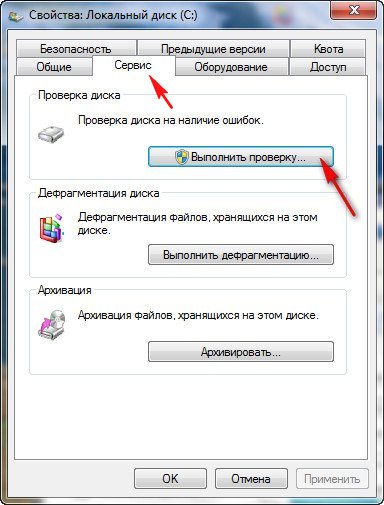
If you tick only item Automatically correct system errors , then the file system will be checked for errors. Noting additionally and the second paragraph Check and repair bad sectors, you also run a check on reading all sectors of the disk being scanned. Know that such a double check will take a long time.

Next, click Start. If a partition with installed Windows is selected for the scan, in most cases (C :), the scan will not start immediately and you will receive such a message “ Windows cannot check the disk that this moment is used. Want to check your drive for crashes the next time you start your computer". Click " Disk check schedule"And the next time the computer boots, the operating system will start a disk check (C :) for errors.
How to run Chkdsk from the command line
For example, we intend to check the disk for errors (C :)

In the command window, enter chkdsk with: / f
Before us there will be a window with the following content: " The Chkdsk command cannot be executed because the specified volume is being used by another process. Should I check this volume on the next reboot? Y (yes) / N (no)"
Agree and click Y. After reboot, our system partition will be checked for errors.
How to run the chkdsk program if your computer does not boot and where novice users make errors
At work, friends I often have to deal with such situations. Well, the operating system does not load and everything, and the most important thing at the same time strangely freezes at any stage of loading, the mouse and keyboard, respectively, no longer respond to user actions. To get out of this situation, you can.
I will give an example for two operating systems: Windows 7 and XP, let's start with Windows 7.
Here we need an installation disk or friends. Each of them has an environment windows recovery 7 and do the same thing. For example, boot the computer from the Windows 7 installation disk. Who does not know how to boot the computer from the installation disk, read the article "".
In the initial phase of booting the computer from the Windows 7 installation disk, “” appears on the screen, immediately press any key on the keyboard (for example, a space), otherwise the message will disappear within 10 seconds and you will not boot from the installation disk or the Windows 7 recovery disk.


You can first choose the tool Startup recovery and if it does not help you boot the system, then choose the tool Command line .

Now friends attention, many users wanting to check the system disk for errors (C :) are mistaken in this place, entering the command chkdsk with: / f,
First of all, you and I need to identify the correct letters of all the disks, since in the recovery environment they usually differ from those that we see in the operating system. So, the disk with the installed Windows most likely belongs not to the letter (C :), but to some other one.
To determine the correct letter of the system disk, in the command line, we need to enter the notepad command and press Enter. A notebook opens. Next, select the File menu and Open.

The contents of the recovery disc open, it is always under the letter (X :). In this window, click the Computer button and enter the Computer window,

here we can easily determine the disk on which the operating system is installed. In order to see the files inside the sections. Select the File type item in the All files drop-down menu.

By the way, if you need, if necessary, you can copy files on any disk to your previously connected USB flash drive, as well as transfer files from disk to disk. For example, you still decide to reinstall Windows, of course your desire will be to transfer all the files you need from the disk (C :) to another disk, all this you can do in this window.
So the disk (C :) turned out to be a hidden partition 100 MB (Main partition) System Reserved (Reserved by the system) this section is needed first of all for location boot files Windows 7 and their protection from careless user actions. If we go to this section, we will see absolutely nothing, because even in the recovery environment these files are not accessible to the user.
The Windows 7 installation disk on which the recovery environment (that is, the drive) is located always belongs to the letter X.
But the disk on which Windows 7 is installed, the recovery environment assigned a letter (D :).
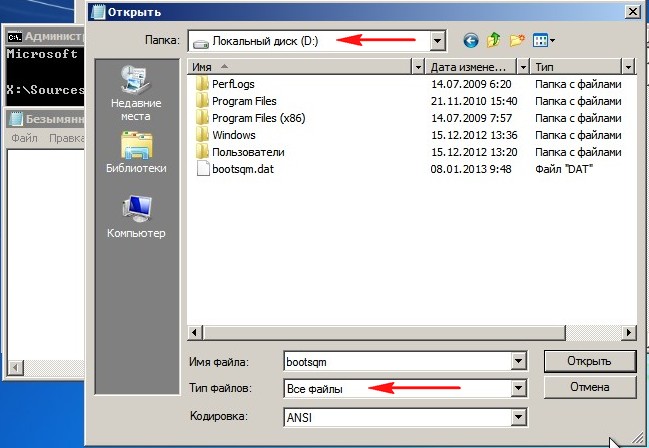
Therefore, to check the disk with the installed operating system, we need to enter in the command line

The system disk check for file system errors begins.
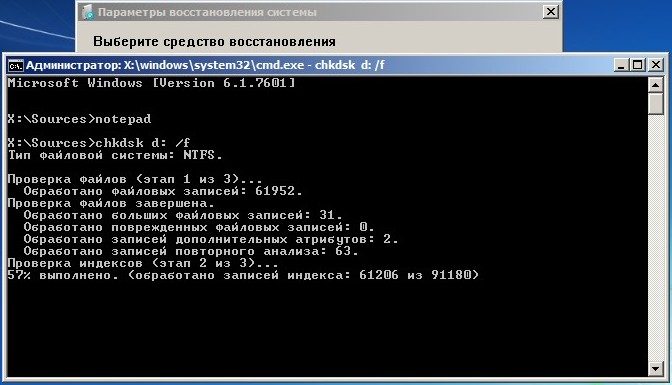
If things are really bad and chkdsk D: / f does not help, try running the utility with parameters
chkdsk D: / f / r
You may receive a warning " Unable to execute Chkdsk command on this volume, because volume is used by another process. To run Chkdsk, you must first disable this volume. ALL OPEN VOLUME DESCRIPTORS WILL BE FURTHER WRONG. Confirm Volume Shutdown". We enter latin letter Y and press Enter on the keyboard. The system disk check for bad sectors will start.

How to run the chkdsk program in the Windows XP operating system, if it does not start
You and I will need a Windows XP installation disc, we will boot into the computer.
In the initial phase of booting from the Windows XP installation disc, the message “ Press any key to boot from CD ...", You must press any key at once, otherwise the inscription will pass within 10 seconds and you will not boot from installation windows Xp.

After a short process of copying files, the program window appears. install windows Xp. It will ask you to reinstall the system or restore the existing one using the Recovery Console (press R). Select Restore using the recovery console and click "R"

If you have one operating system, choose # 1.
Enter admin password. Enter the administrator password. If there is no password, then press Enter on the keyboard.
When the Chkdsk program is used in the Windows XP Recovery Console, the / R parameter is mainly used, which includes the functions of another / P parameter. Therefore, we will use the / R parameter
Enter the command Chkdsk / r
and press Enter, that is, look for the damaged sectors and restore the information.
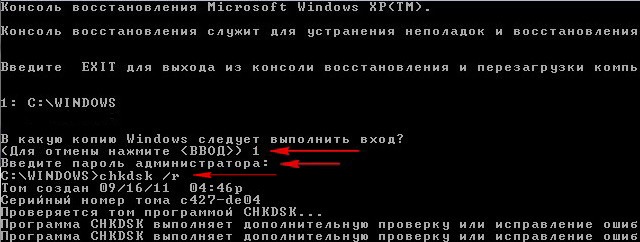
By the way, you can enter the command Chkdsk /? and get acquainted with HELP

You can check whether the disk is marked with a “dirty bit” so that you can enter the command fsutil dirty query C: on the command line, where “C:” is the letter of the disk being checked for “dirty bit”.
As we see in my case volume - C: is not “dirty”

With each booting windows special program Autochk.exe checks all volumes for the presence of a dirty bit. If the dirty bit is set, the Autochk.exe program starts the chkdsk / f program for this volume. That is, the problem volume is checked for errors.
chkdsk / f finds file system errors and tries to fix them.
I must say that in rare cases, the test can occur every time the computer is turned on for several days.
This is annoying to many users. To get rid of this, we select for example a disk (C :), click on it with the right mouse button and select Properties, then Tools and Run check. Check both Automatically fix system errors and second check for damaged sectors, click the start button, then restart the computer and wait for the check to finish.

If this does not help, try the following. We try to disable the disk check using the command line.
Press the key combination Win-R or Start -\u003e Run =\u003e enter cmd command -\u003e click OK. In the window that opens, enter the command
chkntfs / X C: (where C: is the name of the disk that the operating system constantly checks for errors.
Displays a disk status report in a form that depends on the file system used. Team chkdsk also makes a list of errors on the disk and fixes them. Command executed without parameters chkdsk displays information about the status of the current disk.
Syntax
chkdsk [tom: ][[way] file name] [/ f] [/ v] [/ r] [/ x] [/ i] [/ c] [/ l[: the size]]
Options
tom : Specifies the drive letter (followed by a colon), the mount point, or the name of the volume. [ way] file name Specifies the location and file name or the names of the set of files for which the command chkdsk will check the degree of fragmentation. You can use wildcards (* and?) To specify multiple files. / f Specifies the correction of disk errors. The disk must be locked. If the disk is not blocked by the command chkdskA prompt to check the disk the next time you restart your computer. / v Displays the names of the files and directories being scanned. / r Detects bad sectors and restores the part of the data that can still be read. The disk must be locked. / x Use only with file system NTFS. If necessary, initiates a volume shutdown operation as the first action. All open disk handles will be invalid. Parameter / x includes also functionality parameter / f. / i Use only with file nTFS system. Performs a less thorough check of index entries, which reduces the time required for the command to work. chkdsk. / c Use only with the NTFS file system. Skips checking cycles in the folder structure, which reduces the time required for the command to work. chkdsk. / l[:the size] Use with NTFS file system only. Sets the specified log size. If no size is specified, the parameter / l displays the current size. /? Displays help at the command prompt.Notes
- Command execution chkdsk
To execute the command chkdsk for hard drivesYou must be a member of the Administrators group.
- Check locked discs on reboot
If you need to fix disk errors with the command chkdsk, cannot open files on this disk. Otherwise, the following error message is displayed:
The Chkdsk command cannot be executed because the specified volume is being used by another process. Should I check this volume on the next reboot?
If the user selects this option, the command chkdsk check the disk and automatically correct errors when you restart the computer. If the disk partition to be scanned is bootable, the command chkdsk will automatically restart the computer after checking this disk.
- error reporting
Team chkdsk Checks disk space and its usage for FAT and NTFS file systems. Team Chkdsk allows you to get a status report with information for each file system. The disk status report includes a list of errors found. If a team chkdsk running without parameter / f in the active partition, you may receive a message about the presence of serious errors, since the disk can not be locked. To find errors team chkdsk need to run from time to time on each disk.
- Error correction
If command line option is specified / fthe program chkdsk fixes disk errors. When working chkdsk it should be possible to block the disk to correct errors. Since error correction usually changes the file allocation table and sometimes data is lost, the program chkdsk asks for confirmation in the following form:
Lost Clusters: 10; chains: 3.
Convert lost cluster chains to files?
If you enter Y, Windows saves every lost chain in the root directory as a file with the format name File nnnn.chk. After completion chkdsk You can check these files for necessary information. If you enter N, Windows corrects errors on the disk without saving data from the lost blocks.
If the command line parameter / f not used, the program chkdsk only gives a message about the presence of errors in the file, but does not correct them.
If a team chkdsk / f running on a large disk (for example, 70 GB) or a disk contains a large number of files (for example, several million), to close the program chkdsk it may take a lot of time (maybe several days). During this time, the computer will be unavailable to users, since chkdsk does not return control until shutdown.
- Checking disks with the FAT file system
chkdsk about the state of the disk with the FAT file system in the following format:
Volume Serial Number: B1AF-AFBF
72214528 bytes in total on a disk
73728 bytes in 3 hidden files
30,720 bytes in 12 directories
11493376 bytes in 386 user files
61440 bytes in bad sectors
60555264 bytes available on disk
2048 bytes in each cluster
Total clusters on disk: 35,261.
29568 clusters on disk
- Checking drives with the NTFS file system
Windows system displays the program report chkdsk about the state of the NTFS disk in the following format:
File System Type: NTFS.
Checking files ...
File verification complete.
Checking indexes ...
Inspection check completed.
Checking security descriptors ...
Check security descriptors complete.
12372 KB in total on the disk.
3 KB in 1 user files.
4217 KB used by the system.
8150 KB free disk space.
Cluster size: 512 bytes.
Total clusters on disk: 24745.
16301 clusters on disk.
- Using chkdsk with open files
If the parameter is specified / f, team chkdsk displays error message if found on disk open files. If the parameter / f is not specified and open files are found on the disk, chkdsk may display messages about lost blocks on disk. This will occur when open files have not yet been recorded in the file allocation table. If the program chkdsk reports a large number of lost disk space blocks, should be considered the possibility of repairing the disk.
- Physical Disk Error Detection
Use command line option / r to detect physical disk errors in the file system. For information on recovering physically damaged files with the command recover click the link "".
- Report on bad disk sectors
Bad sectors reported by the team chkdsk, were marked on the first formatting of the disk. Such sectors are not dangerous.
- Understanding Program Termination Codes
The following table lists the completion codes that may be contained in the program report. chkdsk after the end of its implementation.
- Team chkdsk with other options available in the recovery console.
Examples
If you want to check the disk in drive D and fix any errors found in Windows, type the following command:
chkdsk d: / f
If an error is found, program execution chkdsk pauses and displays the corresponding messages. At the end of the command chkdsk A report containing the current status of the disk is displayed on the screen. Until the work is completed chkdsk You cannot open any files on the specified drive.
To check the fragmentation of all files in the current directory on a disk with the FAT file system, enter the following command:
chkdsk *. *
Chkdsk displays a report on the status of the disk, and then a list of fragmented files that match the command pattern.
If there are any problems with the hard disk, many immediately have a question about how to start the chkdsk process.
These problems can be very different - from the banal inhibition, which can not be corrected, to a complete failure of the operating system boot.
The fact is that it the best way solve all possible problems with or even. Most experts advise to use it in such situations.
We will consider all the really working methods that help run the tool to restore the railway in Windows.
Contents:
Method number 1. With the help of "Computer"
This option assumes that your system is at least somehow, but it is loading, that is, there is no complete rejection of the download. Yes, it can slow down, from time to time it can reboot spontaneously and so on, but you can still, albeit with attempts, but still see the desktop and other elements of the system. If so, do this:
- Open the "Computer".
- On the main (system), and most often it is on C, right-click and select “Properties” in the drop-down menu.
- In the window that opens, go to the “Service” tab at the top. In the "Check" block, click on "Perform a check ...".
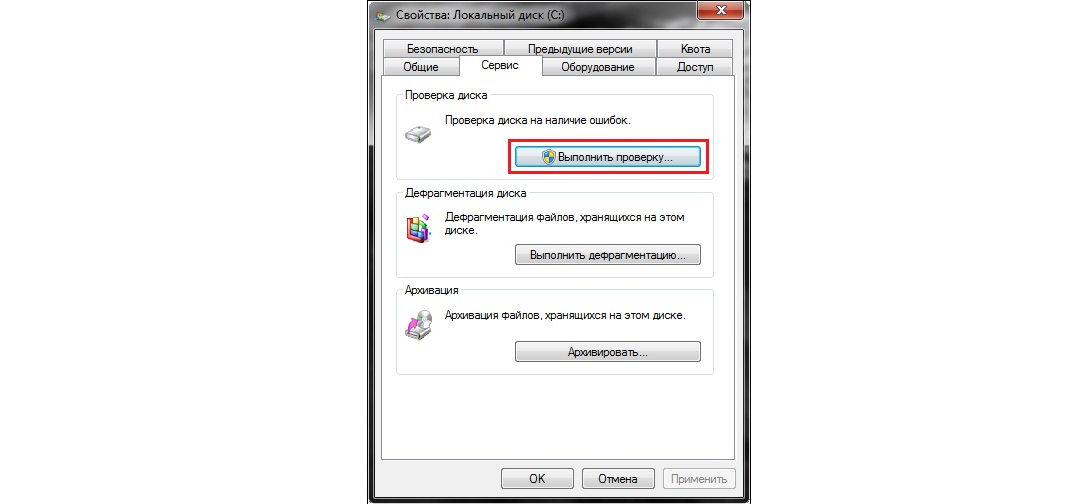
Fig.1. Run Button
- Further a new window will appear, a smaller one. Check the box next to the labels "Automatically fix system errors" and “Check and repair bad sectors”. However, this can not be done, but it is better to put these checkboxes, as you will not be able to do it yourself. Click the "Start" button.

Fig.2. Check window
After that, it will just wait until the tool performs its main task.
In some cases, after performing all the above operations, another window appears with the text: "Windows cannot verify which is currently in use."
This means that some kind of error (regular) has occurred, or you do not have access rights to certain files. This window may look different.
Without going into details, let's say that it will be possible to click the "Yes" or "OK" button. So, you just need to do this and continue to calmly observe the work of the recovery tool.

Fig. 3. "Windows can not run"
Important! In some cases, you will need to restart your PC in order to continue. So if nothing happens after all the above steps, reboot your PC or. It happens that the computer restarts automatically. This should not be afraid.
Method number 2. Use the program execution window
In addition, the recovery tool in question can be launched using a standard or program that is available in all windows versions.
Tip: To start the execution of programs, you can go to the "Start" menu and click "Run." You can also do this by simultaneously pressing the "Win" and "R" buttons.
- Enter the command in the following format: "Chkdsk [drive letter]: / [command]". That is, for example, to check C, you need to enter "chkdsk c: / f". It uses the one that fixes errors on the disk ("/ f"). In addition, you can enter following parameters:
- / f - check and automatically correct errors;
- / i - lack of analysis of the so-called index parts (if you do not know what is meant, do not use this parameter);
- / v - along the way display messages with scanned files (and their paths on the hard disk), as well as other messages about the progress of cleaning and analysis;
- / c - no loops inside folders (again, if you do not know what is meant by this, do not take it);
- / x - turn off the disk before the start (the system will automatically check if there is a need for it and perform the appropriate action);
- / r - search for "broken" sectors and, of course, their automatic recovery;
- / l: [size] - to change the file size, the size must be specified in kilobytes.
In most cases, it all comes down to entering a simple “chkdsk c: / f” command and clicking “OK”.

Fig.4. Enter Correction Phrase
- After that, the verification process will begin. It looks like it is shown in figure №5. Here you just have to wait until it is over.

Fig.5. Verification process
In newer versions, this process looks almost the same, but the interface is slightly different.
Again, after performing the above steps, another one may appear, indicating that the disk “cannot be locked”.
The meaning of this message comes down to the same thing that we talked about above - the disk is currently in use, which means that another failure has occurred or you do not have access to certain elements. In any case, it remains to enter the command “Y” and press the button “Enter”.
Fig. 6. The appearance of an additional window
Important! To use both methods, you must have administrator rights on the computer. It is best to do this on behalf of the administrator. In and below in the "Start" menu there is a corresponding item - "Command line (administrator)". In later versions, in order to see this option, you must click on the "Start" menu or the "Windows" menu. In the line that opens, enter "Net user admin / active: yes".
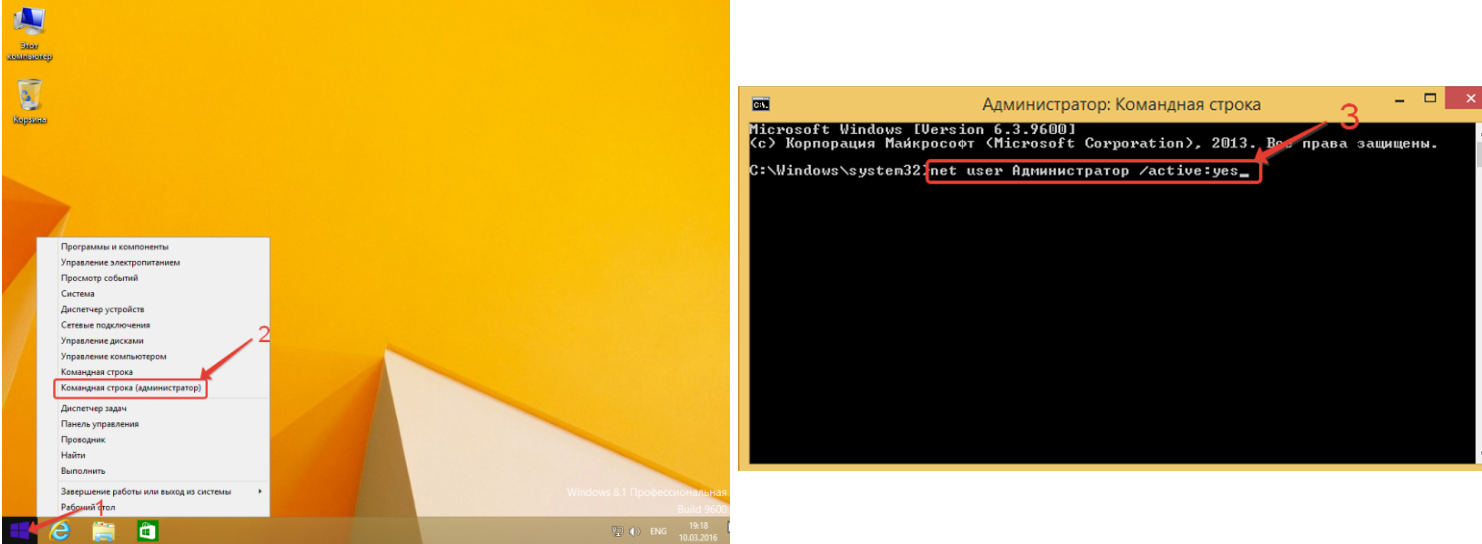
Fig. 7. Input for administrator rights
